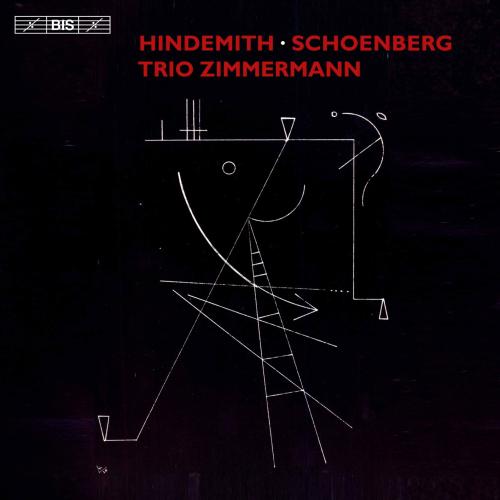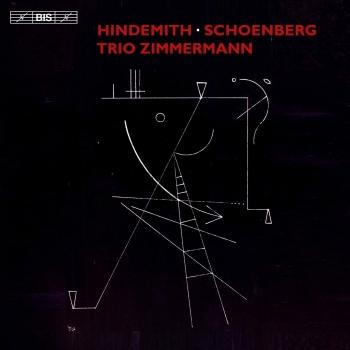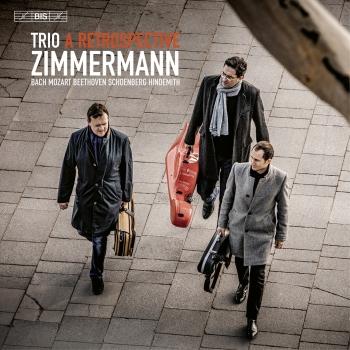
Hindemith & Schoenberg: String Trios Trio Zimmermann
Album info
Album-Release:
2017
HRA-Release:
01.09.2017
Label: BIS
Genre: Classical
Subgenre: Chamber Music
Artist: Trio Zimmermann
Composer: Arnold Schönberg (1874-1951), Paul Hindemith (1895-1963)
Album including Album cover Booklet (PDF)
- Paul Hindemith (1895-1963):
- 1 String Trio No. 1, Op. 34: I. Toccata 04:51
- 2 String Trio No. 1, Op. 34: II. Langsam und mit großer ruhe 06:07
- 3 String Trio No. 1, Op. 34: III. Mäßig schnelle viertel 01:36
- 4 String Trio No. 1, Op. 34: IV. Fuge 06:35
- 5 String Trio No. 2: I. Mäßig schnell 07:35
- 6 String Trio No. 2: II. Lebhaft 06:06
- 7 String Trio No. 2: III. Langsam 07:53
- Arnold Schoenberg (1874-1951):
- 8 String Trio, Op. 45: Pt. 1 01:50
- 9 String Trio, Op. 45: 1st Episode 05:17
- 10 String Trio, Op. 45: Pt. 2 03:10
- 11 String Trio, Op. 45: 2nd Episode 02:32
- 12 String Trio, Op. 45: Pt. 3 05:12
Info for Hindemith & Schoenberg: String Trios
Following their acclaimed recordings of the works for string trio by Mozart and Beethoven, Trio Zimmermann make a great leap in time. Arnold Schoenberg and Paul Hindemith were both at the avant-garde epicentre of the 1910s and 1920s, but their future paths could hardly have been more different. Whereas Schoenberg would go on to have a decisive influence on twentieth-century modernism with his dodecaphonic music and the Second Viennese School, Paul Hindemith gradually renounced his rebellious early music, eventually becoming something of an anachronistic loner.
The relatively early String Trio No. 1 (1924) already betrays the composer's interest in the forms and textures of baroque music. It opens with a flittering Toccata, going on to offer a contrapuntal web in its slow movement and ends with a double fugue. The contrapuntal textures are present also in the Second String Trio, but the neotonal language and general atmosphere point forward to later, large-scale works such as Mathis der Mahler.
In 1933, the year Hindemith composed his second trio, the political developments in Germany caused Arnold Schoenberg to leave Europe for the U.S.A. (Hindemith would follow in 1940.) It took him considerable time before he found his feet in this new environment and continuing financial and professional worries probably contributed to a serious heart attack that struck him down in August 1946. The String Trio, Op. 45, begun shortly before the heart attack and completed a month after it, is the disturbing expression of this extreme near-death experience. It also presents one of the greatest challenges in the entire string repertoire – in fact Schoenberg considered easing the technical difficulties by expanding the trio into a quintet.
Trio Zimmermann
Trio Zimmermann
In 2007 the violinist Frank Peter Zimmermann was able to realize his long-cherished dream to establish a string trio, the Trio Zimmermann, together with the viola player Antoine Tamestit and the cellist Christian Poltéra. All three musicians have their own distinguished solo careers, but they happily meet for one or two short touring periods per season. The trio performs in such musical centres as Amsterdam, Berlin, Brussels, Cologne, London, Milan, Munich, Paris, Vienna and Zürich, as well as during the festivals in Salzburg and Edinburgh. The Trio Zimmermann records for BIS Records and their award-winning releases so far include the Beethoven String Trio’s Op. 9 (Diapason d’Or de l’Année in 2012, and a BBC Music Magazine Award in 2013), Beethoven’s String Trio, Op. 3 and the Serenade, Op. 8, and the Mozart Divertimento KV 563.
Frank Peter Zimmermann
is one of the most highly sought-after violinists of his generation. Since finishing his studies with Valery Gradov, Saschko Gawriloff and Herman Krebbers, he has performed with all the world’s major orchestras, collaborating on these occasions with the world’s most renowned conductors. His many concert engagements take him to all major concert venues and international music festivals in Europe, the United States, Asia, Australia and South America. Recent additions to his wide-ranging and award- winning discography on BIS, Decca, Sony, EMI and ECM include recordings of concertos by Dvořák, Hindemith, Shostakovich and Brett Dean.
He plays on the 1711 Antonio Stradivari violin "Lady Inchiquin”, which is kindly provided by the Kunstsammlung Nordrhein-Westfalen, Düsseldorf, "Kunst im Landesbesitz".
Antoine Tamestit
is one of today’s most sought-after violists. Appearing with major international orchestras, he remains a passionate chamber musician, playing with the leading artists of our time. His wide repertoire extends from baroque to contemporary music and he has premiered many new and important works. He is artistic director of the Viola Space Festival in Tokyo.
Born in Paris, Tamestit studied with Jean Sulem, Jesse Levine and Tabea Zimmermann. He is the recipient of several awards, including the Credit Suisse Young Artists Award and first prizes at the Primrose International Viola Competition and the ARD International Music Competition. Antoine Tamestit plays on the Stradivarius viola "Mahler" from 1672, on loan from the Habisreutinger Foundation.
Christian Poltéra
was a pupil of Nancy Chumachenco, Boris Pergamenschikow and Heinrich Schiff. Between 2004 and 2006 he was a member of the prestigious New Generation Artists’ scheme of BBC Radio 3 in London and in 2004 received the Borletti-Buitoni Award. As a soloist he gives concerts with numerous renowned orchestras and conductors. He is also a passionate chamber musician, working with many distinguished fellow artists, and is a frequent guest at various illustrious festivals. Christian Poltéra’s internationally acclaimed discography include numerous releases on BIS and reflects his wide range of concerto and chamber music repertoire. He plays on the famous ’Mara’ cello made by Stradivarius in 1711.
Booklet for Hindemith & Schoenberg: String Trios











